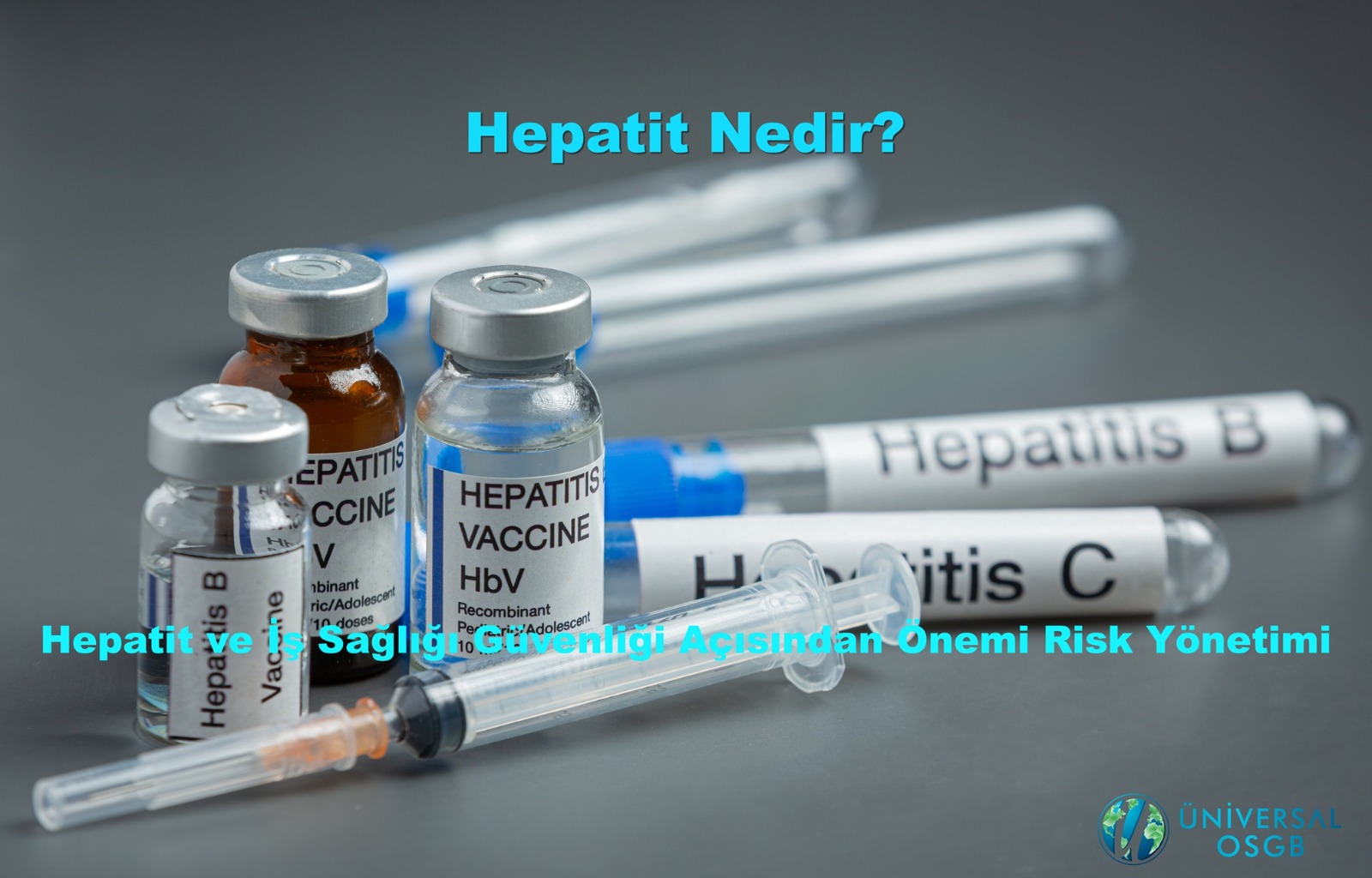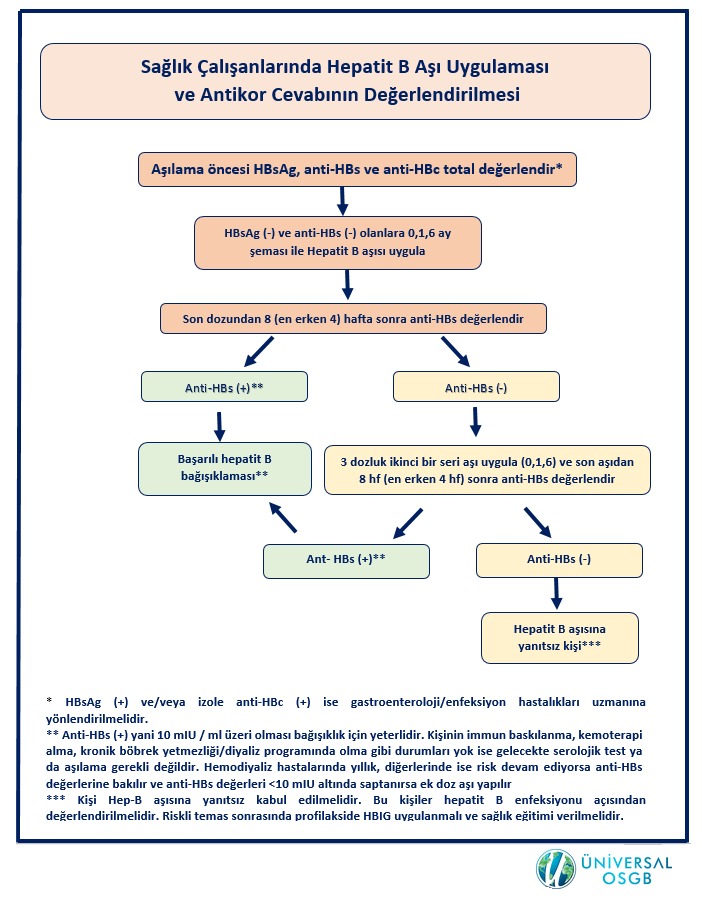
What is Hepatitis? Hepatitis and Its Importance in Occupational Health and Safety Risk Management
What is Hepatitis? Hepatitis and Its Importance in Occupational Health and Safety Risk Management
Hepatitis refers to inflammation of the liver tissue. It can occur for various reasons:
Viral causes: Hepatitis A, B, C, D, and E viruses
Toxic causes: Alcohol, certain medications, chemical substances
Autoimmune causes: The immune system attacking the liver
Metabolic causes: Wilson's disease, alpha-1 antitrypsin deficiency, etc.
Types of Viral Hepatitis
Hepatitis A (HAV):
Spreads through the fecal-oral route (contaminated water and food).
It is acute and does not become chronic.
There is a vaccine.
Hepatitis B (HBV):
Transmitted through blood, sexual contact, and from mother to baby.
Can be acute or chronic.
If chronic, it can lead to cirrhosis and liver cancer.
There is a vaccine.
Hepatitis C (HCV):
Transmitted through blood (especially needle sharing, contaminated medical procedures).
Most cases become chronic.
It can be completely cured with effective antiviral treatments available today.
There is no vaccine.
Hepatitis D (HDV):
It only occurs in conjunction with Hepatitis B.
It aggravates HBV infection.
Hepatitis E (HEV):
It is usually transmitted through water.
It is acute and can cause severe complications in pregnant women.
The vaccine is available in limited areas.
Hepatitis Symptoms
- Fatigue, weakness
- Loss of appetite, nausea
- Abdominal pain (especially in the right upper quadrant)
- Dark urine, pale stools
- Jaundice (yellowing of the eyes and skin)
- Itchy skin
Diagnostic Methods
- Blood tests: Liver enzymes (ALT, AST), bilirubin
- Serological tests: HBsAg, Anti-HCV, Anti-HAV IgM, etc.
- PCR tests: Virus RNA/DNA detection
- Liver biopsy: To determine the level of damage in chronic cases
Treatment and Prevention
Hepatitis A and E: Supportive treatment, hygiene, clean water and food.
Hepatitis B: Antiviral drugs (tenofovir, entecavir), prevention with vaccination.
Hepatitis C: Over 95% cure rate with direct-acting antivirals (DAA).
Hepatitis D: Treatment is difficult; pegylated interferon may be used.
General prevention:
- Vaccination (for HAV, HBV)
- Safe blood transfusion
- Single-use medical supplies
- Protection during sexual intercourse
- Hygiene and sanitation
Hepatitis Risk in the Workplace (from an OSH perspective)
- Healthcare workers, laboratory workers, and dialysis personnel are at risk.
- There is a risk of hepatitis transmission in sectors with a high likelihood of contact with blood and
- body fluids (healthcare, veterinary medicine, cosmetics, tattoo/piercing studios).
OHS measures:
- Administration of the HBV vaccine
- Use of PPE such as gloves, masks, and goggles
- Prevention of injuries from sharp instruments
- Regular training on biological risks
Hepatitis and Its Importance in Occupational Health and Safety
Hepatitis is the inflammation of liver tissue due to various viral, toxic, or autoimmune causes. Viral hepatitis (A, B, C, D, E), in particular, is a significant public health problem worldwide and poses a critical risk in occupational health and safety (OHS). Healthcare workers, laboratory personnel, and occupational groups in contact with blood/body fluids are at high risk for hepatitis. This article discusses hepatitis types, transmission routes, prevention methods, and the OHS dimension.
Hepatitis is a disease that can develop due to infectious and non-infectious causes. According to the World Health Organization (WHO), approximately 296 million people live with chronic Hepatitis B and 58 million people live with chronic Hepatitis C (WHO, 2023). This high prevalence poses a serious threat, especially to the healthcare sector and other occupations at biological risk.
Types of Hepatitis and Clinical Features
- Hepatitis A (HAV): Spreads through the fecal-oral route, usually has an acute course, and does not become chronic.
- Hepatitis B (HBV): Spreads through blood and sexual contact, carries a risk of becoming chronic, and is a major cause of cirrhosis and hepatocellular carcinoma.
- Hepatitis C (HCV): Spreads mainly through blood, most cases become chronic, treatable with antiviral medications.
Hepatitis D (HDV): Only occurs in conjunction with HBV, aggravates the course of the disease.
Hepatitis E (HEV): Spreads through water and food, mortality rate is high in pregnant women.
Hepatitis from an Occupational Health and Safety Perspective
Hepatitis viruses can be transmitted through blood and body fluids, posing a risk of occupational disease in certain professions.
Occupations at Risk
- Healthcare workers (physicians, nurses, laboratory technicians, dentists)
- Dialysis center workers
- Veterinarians
- Cosmetic and tattoo/piercing workers
- Waste collection and recycling workers
Occupational Transmission Routes
- Injuries from sharp instruments
- Contact with blood and body fluids
- Contact with contaminated surfaces
- Poor hygiene
Prevention Methods
- Vaccination: Effective vaccines are available for Hepatitis A and B. Healthcare workers should be required to receive the HBV vaccine.
- Personal Protective Equipment (PPE): Use of gloves, masks, goggles, and aprons.
- Training and Awareness: Providing regular biological risk training to employees.
- Hygiene Measures: Hand washing, sterilization, use of disposable materials.
- Workplace Arrangements: Collection of sharps waste in special containers.
Hepatitis is an important infectious disease in terms of both public health and occupational health. Individuals working in the healthcare sector, in particular, should undergo regular screening and vaccination as part of biological risk management.
References
- World Health Organization (WHO). (2023). Hepatitis. Retrieved from: https://www.who.int/health-topics/hepatitis
- Ministry of Health of the Republic of Turkey. (2022). Viral Hepatitis Prevention and Control Program. Ankara.
- Centers for Disease Control and Prevention (CDC). (2023). Viral Hepatitis. Available at: https://www.cdc.gov/hepatitis/
Lok, A. S., & McMahon, B. J. (2021). Chronic hepatitis B. New England Journal of Medicine, 384(8), 780-793. - Thomas, D. L. (2022). Global elimination of chronic hepatitis. New England Journal of Medicine, 387(3), 215-224.

For more information, please contact us.
Üniversal OSGB
Occupational Safety and Worker Health Center


